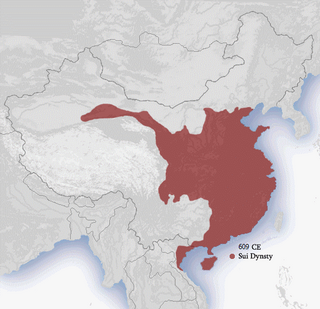 W
WThe Sui dynasty was a short-lived imperial dynasty of China of pivotal significance. The Sui unified the Northern and Southern dynasties and reinstalled the rule of ethnic Han in the entirety of China proper, along with sinicization of former nomadic ethnic minorities within its territory. It was succeeded by the Tang dynasty, which largely inherited its foundation.
 W
WSogdia or Sogdiana was an ancient Iranian civilization that at different times included territory located in present-day Uzbekistan, Tajikistan, Kazakhstan, and Kyrgyzstan, such as Samarkand, Bukhara, Khujand, Panjikent, and Shahrisabz. Sogdiana was also a province of the Achaemenid Empire, eighteenth in the list on the Behistun Inscription of Darius the Great. In the Avesta, Sogdiana is listed as the second best land that the supreme deity Ahura Mazda had created. It comes second, after Airyanem Vaejah, "homeland of the Aryans", in the Zoroastrian book of Vendidad, indicating the importance of this region from ancient times. Sogdiana was first conquered by Cyrus the Great, the founder of the Achaemenid Empire. The region would then be annexed by the Macedonian ruler Alexander the Great in 328 BC. The region would continue to change hands under the Seleucid Empire, Greco-Bactrian Kingdom, Kushan Empire, Hephthalite Empire, and Sasanian Empire.
 W
WThe Anji Bridge is the world's oldest open-spandrel segmental arch bridge of stone construction. Credited to the design of a craftsman named Li Chun, the bridge was constructed in the years 595–605 during the Sui dynasty (581–618). Located in the southern part of Hebei Province, it is the oldest standing bridge in China.
 W
WChang'an was an ancient capital of more than ten dynasties in Chinese history, today known as Xi'an. Chang'an means "Perpetual Peace" in Classical Chinese since it was a capital that was repeatedly used by new Chinese rulers. During the short-lived Xin dynasty, the city was renamed "Constant Peace" ; the old name was later restored. By the time of the Ming dynasty, a new walled city named Xi'an, meaning "Western Peace", was built at the Sui and Tang dynasty city's site, which has remained its name to the present day.
 W
WThe Cheng'en Temple is a Buddhist temple located in Beijing, China. It was first founded during the Sui dynasty, but later rebuilt several times, notably between 1510 and 1513 by the Zhengde Emperor of the Ming dynasty. The temple's main Daxiong Palace, clock and drum towers, as well its stone sculpted Buddhas were all constructed during the Ming dynasty. The temple also contains important collection of Ming dynasty Chinese religious art, such as the murals on the interior walls of the Hall of Heavenly Kings.
 W
WThe Four Gates Pagoda is a Sui dynasty stone Chinese pagoda located in central Shandong Province, China. It is thought to be the oldest remaining pavilion-style stone pagoda in China. The oldest extant brick-built pagoda in China is the 40-metre-tall (130 ft) Songyue Pagoda of 523 AD.
 W
WThe Grand Canal, known to the Chinese as the Jing–Hang Grand Canal, a UNESCO World Heritage Site, is the longest canal or artificial river in the world. Starting in Beijing, it passes through Tianjin and the provinces of Hebei, Shandong, Jiangsu, and Zhejiang to the city of Hangzhou, linking the Yellow River and Yangtze River. The oldest parts of the canal date back to the 5th century BCE, but the various sections were first connected during the Sui dynasty. Dynasties in 1271–1633 significantly restored and rebuilt the canal and altered its route to supply their capital.
 W
WHuteng was the Chinese term for a type of dance that originated in Central Asia, especially among the Sogdians and the region of Tashkent. The dance was well known during the Tang dynasty, and there are numerous depictions of it in works of art. The dance was characterized by spinning, leaps and backflips. The dancers would particularly make summersaults, first planting their feet firmly on the carpet, tilting their face upward and arching their body, then lift their arms and jump backward to the sound of flutes and the pipa.
 W
WThe Qieyun is a Chinese rhyme dictionary, published in 601 during the Sui dynasty. The book was a guide to proper reading of classical texts, using the fanqie method to indicate the pronunciation of Chinese characters. The Qieyun and later redactions, notably the Guangyun, are important documentary sources used in the reconstruction of historical Chinese phonology.
 W
WThe Tomb of Yu Hong (Chinese: 虞弘墓; pinyin: Yú Hóng Mù; Wade–Giles: Yü2-Hung2-Mu4) is the grave of Yu Hong and his wife, dating back to 592 AD (Sui dynasty). The tomb was discovered by some locals in 1999 in Wangguo village in Jinyuan district of the city of Taiyuan, it was subsequently excavated officially in July of the same year. This tomb is so far the only archaeological find in the Central Plains region that reflects Central Asian (Western Regions) culture.